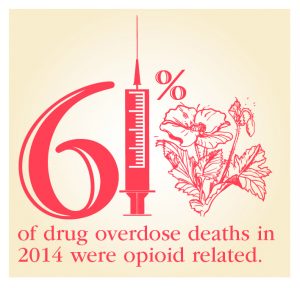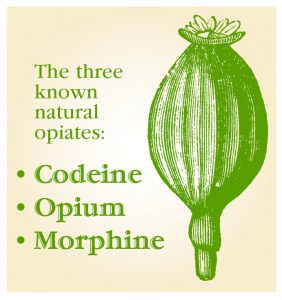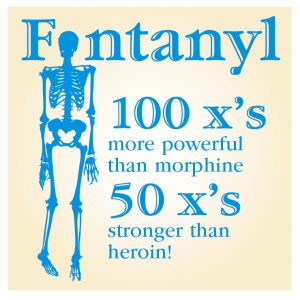While prescription opioids and heroin have left a trail of destruction in the U.S. over the last 15 years, synthetic opioids like fentanyl, W-18 and krokodil have emerged as even greater threats. Just how scared should we all be of this new wave of synthetic opioids?

A Troubling Trend in America’s Worst Drug Epidemic
America is in love with opioids. From rampant heroin abuse and addiction to flagrant prescription painkiller misuse, it’s clear that this is a problem that has only worsened. A record number of Americans (more than 47,000) died from drug overdoses in 2014, with 61 percent of those people overdosing on opioids. One can point to the more than 100 million Americans suffering from chronic pain, irresponsible prescribing by doctors or the easy path from painkillers to heroin as catalysts for the worst drug epidemic our nation has ever seen.
As scary as these numbers are, the rise of new synthetic opioids may make the problem even worse. Similar to other synthetic drugs, synthetic opioids are created to mimic the painkilling and euphoric effects of natural opiates like codeine and morphine. Unlike other synthetic drugs, synthetic opioids can be broken down into two separate groups: synthetic opioids and semi-synthetic opioids.
What is a Synthetic Opioid?
 An opiate is a substance created from the naturally occurring alkaloids from the resin of opium poppy. The only three known natural opiates are codeine, opium and morphine. Although drugs like heroin and Oxycodone are often grouped in with opiates, they are actually considered semi-synthetic opioids because they are derived from other naturally occurring opiates.
An opiate is a substance created from the naturally occurring alkaloids from the resin of opium poppy. The only three known natural opiates are codeine, opium and morphine. Although drugs like heroin and Oxycodone are often grouped in with opiates, they are actually considered semi-synthetic opioids because they are derived from other naturally occurring opiates.
A synthetic opioid is created using chemicals not found in the poppy plant or from morphine, codeine or opium. The actual chemicals used vary from drug to drug and chemist to chemist. This mystery is what makes using a synthetic opioid developed or used outside of a clinical setting extremely dangerous. Users and abusers have no idea what they’re taking or about the potency of the dosage. The three major synthetic opioid threats on the market include fentanyl, W-18 and krokodil.
Why Fentanyl is Scaring Everyone
 As strong as heroin or prescription drugs like oxycodone are, they become much more powerful and dangerous when mixed with fentanyl. This prescription opioid is often administered to patients following a surgery, and is reported to be as much as 100 times more powerful than morphine and 50 times stronger than heroin. Reports of nonmedical usage of fentanyl combined with seizures of heroin and prescription pills cut with the drug have put government officials and law enforcement agencies across the nation on high alert.
As strong as heroin or prescription drugs like oxycodone are, they become much more powerful and dangerous when mixed with fentanyl. This prescription opioid is often administered to patients following a surgery, and is reported to be as much as 100 times more powerful than morphine and 50 times stronger than heroin. Reports of nonmedical usage of fentanyl combined with seizures of heroin and prescription pills cut with the drug have put government officials and law enforcement agencies across the nation on high alert.
Though abuse of fentanyl began in the 1980s, the last few years have seen an explosion in the drug’s popularity. The National Forensic Laboratory Information System (NFLIS) reported 3,334 fentanyl sample submissions to state and local labs in 2014, a stark increase from 942 in 2013.
Dealers are lacing fentanyl with heroin and prescription drugs to increase potency and decrease costs. The result is users blindly taking powerful doses of unknown amounts of fentanyl, potentially overtaxing their bodies and putting their lives at risk. The Drug Enforcement Administration (DEA) issued a nationwide alert about fentanyl in March, 2015.
The Threat from W-18 and Krokodil
Krokodil earned its name from the damage it causes to a user’s skin, turning it green and eventually rotting it away.
While the fentanyl scare has dominated headlines, both krokodil and W-18 may represent emerging national drug threats. A mystery still exists about the exact nature of W-18, but many experts have classified it as an opioid due to its analgesic properties. It is said to be 100 times more potent than fentanyl and 10,000 times stronger than morphine. This synthetic drug was created in the early 1980s, but was never approved for clinical testing. Though seizures of the drug on U.S. soil remain miniscule, increasing appearances in Canada have caused some concern among drug and law enforcement agencies.
Krokodil, also known as desomorphine, is a semi-synthetic opioid made with a combination of codeine and other ingredients, which include iodine, red phosphorous, paint thinner, gasoline, lighter fluid and hydrochloric acid. The drug originally appeared in Russia as a cheap alternative to heroin, but has recently made its way to American shores. Krokodil earned its name from the damage it causes to a user’s skin – turning it green and eventually rotting it away.
Constantly Changing
The work of rogue chemists never ends. As law enforcement catches onto new synthetic opioids and adjusted formulas, chemists respond by creating more analogs and different drugs. Other synthetic opioids include:
- Dilaudid
- Demerol
- Vicodin
- Methadone
“Chemists at Work” is turning into a very dangerous statement in the world of synthetic opioids.



